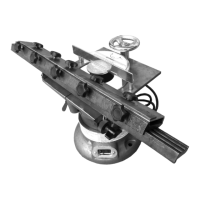Model G2790 (Mfd. Since 04/13)
-19 -
Wheel Inspection &
Ring Test
Do not assume that a grinding wheel is in sound
condition just because it is new or looks okay.
Often damage can occur in shipping, with age,
or with exposure to moisture, and may not be
visible. Inspect every wheel for damage before
installation.
First, do a visual inspection. Look for any cracks,
chips, nicks or dents in the surface of the wheel. If
you see any of these, DO NOT use the wheel.
Second, do a ring test. This test will give you an
indication of any internal damage that may not be
obvious during a visual inspection. If the wheel
does not pass the ring test, DO NOT use the
wheel.
To perform a ring test:
1.
Make sure the wheel that you test is clean and
dry—otherwise, you may get false results.
2.
If size permits, balance the wheel with your
finger in the center hole. If this is not possible,
hang the wheel in the air with a piece of cord
or string looped through the center hole.
3.
At the four spots on the wheel shown in
Figure 13, gently tap the wheel with a non-
metallic object, such as a screwdriver handle
or wooden mallet.
Figure 13. Tapping locations for a ring test.
4.
An undamaged wheel will emit a clear metal-
lic ring or “ping” sound in each of the four
spots. A damaged wheel will respond with a
dull thud that has no clear tone.
— If you determine from the results of the ring
test that the wheel is damaged, DO NOT
use it!
Mounting Pivot
Support
The pivot support is used to hold the stationary
clamps for narrow tools and the slide table and
bar for wide knives.
To mount the pivot support on the grinder
table:
1.
DISCONNECT MACHINE FROM POWER!
2. Loosen the four lock knobs on the sides of the
pivot support, then slide the support flanges
onto the table, as shown in Figure 14.
3.
Use the knurled wheel of the pivot gear to
set the correct angle for your operation, then
tighten all four lock knobs.
Figure 14. Pivot support installed.
Lock
Knob
Pivot Gears
Pivot Support
Flange

